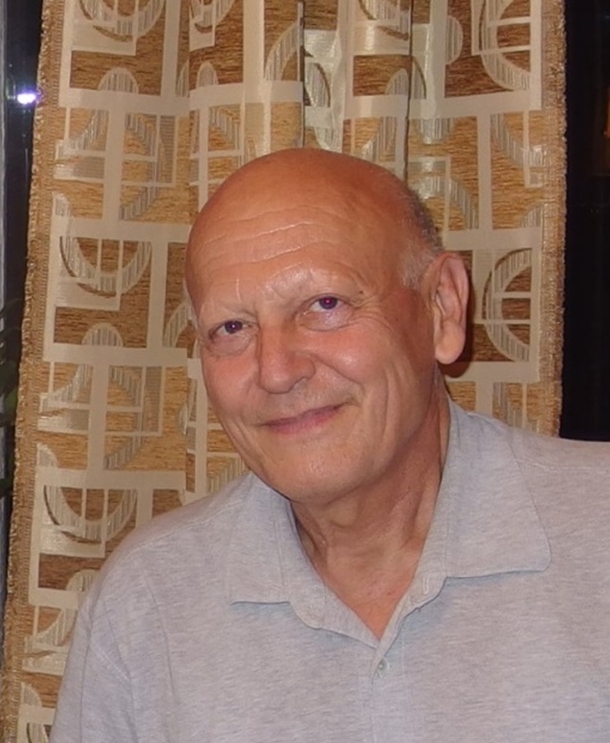
In the last few years, theoretical results have been obtained in:
- electronic non-radiative transitions in isolated molecules;
- a method has been developed for calculation of highly excited
vibration states in polyatomic molecules and study of the vibration relaxation
of these states.
Prof. DSc. Svetoslav Rashev

Born
1948, in Bourgas, Bulgaria.
Graduated
Sofia University, Physical Department, 1973.
PhD,
Karpov Institute of Physical Chemistry, Moscow,
1983. Supervisor: Professor Victor G. Plotnikov.
Dr. of
Sciences, 1996, at ISSP BAS.
Employed
at the Institute of Solid State Physics at the
Bulgarian Academy of Sciences (ISSP BAS), Department for
Optics&Spectroscopy, since 1973.
Present
position: Professor.
Main Fields of
Theoretical Research Activity:
Molecular Spectroscopy,
Molecular
Vibrational Dynamics and Relaxation,
Electronic Radiationless Transitions in Isolated Polyatomic Molecules,
Molecular
Symmetry,
Large Scale
Vibrational Calculations,
RECENT
AND
PRESENT RESEARCH ACTIVITY
Theoretical work has been
done in the recent years, on
the construction and elaboration of a vibrational procedure and
computer code,
designed for implementation of large scale vibrational calculations on
formaldehyde H2CO and thiophosgene Cl2CS.
The procedure
is based on the following key ideas:
-- Combined local
modes/symmetrized modes formalism (LM/SM), for the molecular
vibrational modes;
we employ an exact expression for the molecular kinetic energy operator
and a
quartic potential energy surface (PES); the force constants of the
quartic PES
have been originally obtained using high level ab initio
computations [with the nwchem suite
of ab initio programs, using a cc-p VTZ correlation consistent
polarized triple
valence basis, further corrected for electron correlation by CCSD(T)];
next,
the ab initio calculated quadratic, cubic and quartic force constants
were
refined, using our large scale variational method and a nonlinear least
squares
fitting algorithm and comparing our calculated frequencies to the
experimentally measured frequencies of formaldehyde and thiophosgene.
-- The employed
vibrational calculation procedure is variational; it is based on an
artficial
intelligence (AI) search algorithm for selecting the appropriate active
space
(AS) of basis states and setting up the relevant Hamiltonian matrix. In
order
to obtain the required molecular vibrational energy levels, the
Hamiltonian
matrix is diagonalized numerically, using a Lanczos tridiagonalization
routine.
The dimensionality of the obtained Hamiltonian matrices may amount to
100000 or
larger.
--
Using the vibrational procedure and code, large scale
calculations have been performed on the vibrational frequencies of
ground
electronic state formaldehyde and thiophosgene both in the lower
excitation
domain, where we obtained very good coincidence of the theoretically
calculated
and the experimentally measured frequencies, as well as in the highly
excited
vibrational excitation energy range, to explore the characteristics of
IVR and
vibrational level mixing.
-- In particular for S0
thiophosgene, we have been able to extend the large scale vibrational
calculations up to the dissociation limit at ~20000 cm-1,
where we
compared our results on the features IVR and vibrational isolation with
the
recent spectroscopic measurements on “feature” states as well as with
the
conclusions derived from local coupling models by other authors.
SOME PUBLICATIONS
S. Rashev and D. C. Moule, Spectrochim. Acta A: Mol. Biomol. Spectr. 140, p.305-310 (2015).
“A Refined Quartic Potential Energy Surface and large scale vibrational calculations for S0 Thiophosgene.”
S. Rashev and D. C. Moule, Prog. Theoret. Chem. Phys. B27: Advances in Quantum Methods and Applications in Chemistry, Physics, and Biology, Chapter 8, p.141-160 (Springer, 2013).
“A Refined Quartic Potential Energy Surface for S0 Formaldehyde.”
S. Rashev and D. C. Moule, J. Molec. Spectrosc. 286-287, p.21-29 (2013).
“Large Scale Variational Calculations on the Vibrational Level Structure and Vibrational Mixing in S0 HDCO up to Very High Excitation Energies.”
S.Rashev, D.C.Moule and V.Rashev, Spectrochim.Acta A: Mol.Biomol.Spectr. 97, p.111-118 (2012).
“Variational Study on the Vibrational Level Structure and Vibrational Level Mixing of Highly Vibrationally Excited S0 D2CO.”
S.Rashev and D.C.Moule, Spectrochim.Acta A: Mol.Biomol.Spectr. 87, 286-292 (2012).
“Variational Study on the Vibrational Level Structure and IVR Behavior of Highly Vibrationally Excited S0 Formaldehyde.”
S. Rashev, D.C. Moule and R.H. Judge, Int.J.Quant.Chem. 111 (2), 279-287 (2011).
“The Role of Rotational Relaxation in the Intersystem Crossing Between a Triplet and a Singlet Electronic State.”
S. Rashev and D.C. Moule, J. Chem. Phys., 130(13), 134307 (2009).
“Rotational Level Involvement in the T1→S0 Intersystem Crossing Transition in Thiophosgene.”
S. Rashev and D.C. Moule, J. Chem. Phys., 128(9), 31295391 (2008).
“A Combined Theoretical Treatment of Intersystem Crossing and Intramolecular Vibrational Redistribution in Thiophosgene”.
S. Rashev, D.C. Moule and S. Djambova, Chem. Phys. Letters, 441(1-3), pp.43-47 (2007).
“On the T1→S0 Intersystem Crossing Rate Constant in Thiophosgene”.
S. Rashev, I.M. Bivas and D.C. Moule, Chem. Phys. Letters, 438 (4-6), pp.153-156 (2007).
“Large Scale Vibrational Hamiltonian Calculations on Thiophosgene”.
S. Rashev, D.C. Moule and S. Djambova, J. Phys. Chem. A 110 (51), p.13769-13774 (2006).
“Empirical Determination of The Harmonic Force Constants in Benzene. 4. The Fermi Resonances”.
S.
Rashev and D.C. Moule, J. Molec.
Spectrosc. 235
(1), pp.93-103 (2006).
“Hamiltonian description and 6D calculations on the ammonia vibrational
levels”.
S.
Rashev, Recent Research Developments
in Physical Chemistry, Transworld
Research Network, 37/661 (2),
p.279-308 (2004).
“Large Scale Quantum Mechanical Calculations on the Benzene Vibrational
System”.
S.
Rashev and D.C. Moule, J. Phys.
Chem. A 108 (7),
p.1259-1267 (2004).
“Empirical Determination of The Harmonic Force Constants in
Benzene. 3.
The Harmonic Frequencies.”
S.
Rashev, Int. J. Quantum Chem.
99 (6), p.894-902 (2004).
“Determination of an improved set of harmonic force constants for
benzene”.
S. Rashev
and D.C. Moule, Chem. Phys.
295 (2), p.109-117 (2003).
“Calculations on the
Vibrational Level Density
in Formaldehyde.”
S. Rashev,
J. Phys. Chem. A 107
(13), p.2160-2171 (2003).
“Empirical
Determination of The Harmonic Force Constants in Benzene. 2.
The C-H
Stretch System.”
S.
Rashev, Int. J. Quantum Chem. 89
(4), p. 292-298 (2002).
“Complex
Symmetrized Analysis of Benzene Vibrations”.
S. Rashev, J.
Phys. Chem. A 105 (26), p. 6499-6505
(2001).
“On the
Empirical Determination of Some Harmonic and Anharmonic Force
Constants
in Benzene”.